Bond Strength Properties of GFRP and CFRP according to Concrete Strength
Abstract
:1. Introduction
2. Manufacturing Process of GFRP and CFRP
3. Experimental Procedure
3.1. Materials
3.2. Experimental Test Methods
4. Results and Discussion
4.1. Compressive Strength
4.2. Bond Strength
4.3. Bond Strength and Slip Relationship
4.4. Comparison by Fiber Type
5. Conclusions
- (1)
- While investigating the relationship between bond strength and slip, bond strength tended to increase after rib failure in the concrete with a 40% water–cement ratio. This can be attributed to the increased bond strength in the remaining intact concrete–rebar ribs under high compressive strength.
- (2)
- For all water–cement ratios, it was found that higher the compressive strength of the concrete, the better the adhesion strength between the concrete, and the CFRP or GFRP. This could be attributed to the effect on the increase in strength.
- (3)
- When comparing the bonding strength of the GFRP and CFRP, the bonding strength of the CFRP, which has higher tensile strength, was greater than that of the GFRP. This could be attributed to the resistance offered by the reinforcing bar with high tensile strength against the pull-out load even under the same frictional force.
Author Contributions
Funding
Conflicts of Interest
References
- Lee, Y.H.; Choi, J.H.; Kim, H.C.; Kim, D.H.; La, S.J. Experimental Study on Bond Strength of CFRP Rebar in concrete. J. Archit. Inst. Korea 2008, 24, 53–60. [Google Scholar]
- Saetta, A.V.; Scotta, R.V.; Vitaliani, R.V. Analysis of chloride diffusion into partially saturated concrete. ACI Mater. J. 1993, 90, 441–451. [Google Scholar]
- Kim, J.S.; Lee, S.H. Bond Behaviors of Epoxy Coated Reinforcements Using Direct Pull-out Test. J. Korean Recyl. Constr. Res. Inst. 2017, 5, 298–304. [Google Scholar]
- Oh, B.H.; Kim, K.H.; Jang, S.Y.; Jing, T.R.; Jang, B.S. Cracking Behavior of Reinforced Concrete Structures due to Reinforcing Steel Corrosion. J. Korea Concr. Inst. 2002, 14, 851–863. [Google Scholar]
- Lee, S.T.; Park, K.P.; Park, K.T.; You, Y.J.; Seo, D.W. A Study on the Application of FRP Hybrid Bar to Prevent Corrosion of Reinforcing Bar in Concrete Structure. J. Korea Acad. Ind. Coop. Soc. 2019, 20, 559–568. [Google Scholar]
- Okelo, R.; Robert, L.Y. Bond strength of fiber reinforced polymer rebars in normal strength concrete. J. Compos. Constr. 2005, 9, 203–213. [Google Scholar] [CrossRef]
- Lee, J.Y.; Yi, C.K.; Kim, T.Y.; Park, J.S.; Park, Y.H. Bond Failure Surface of Glass Fiber Reinforced Polymer Bars. J. Korea Concr. Inst. 2008, 20, 383–391. [Google Scholar]
- ACI Committee 440. Guide for the Design and Construction of Concrete Reinforce with FRP Bars. 2006. Available online: https://basalt-fibers.com/wp-content/uploads/2021/05/Standart_ACI-4401R15.pdf (accessed on 12 September 2022).
- Kim, T.Y.; Park, J.S.; Lee, J.Y.; Kim, K.H. Effect of Compressive Strength of Concrete on the Bond Strength of Glass Fiber Reinforcement Plastic Bars. J. Archit. Inst. Korea 2005, 21, 69–76. [Google Scholar]
- You, Y.J.; Park, Y.H.; Park, J.S. Service and Ultimate Load Behavior of Bridge Deck Reinforced with GFRP Rebars. J. Korean Soc. Civil Eng. 2008, 28, 719–727. [Google Scholar]
- Kim, H.J.; Kim, J.S.; Kim, Y.J.; Choi, J.W.; Park, S.G. Bond Strength Properties of CFRP Rebar in Concrete According to the Concrete Strength. J. Korean Recycl. Constr. Res. Inst. 2017, 9, 569–577. [Google Scholar]
- Yoon, S.J.; Ho, S.W.; Kim, K.S. An Experimental Study about Flexural Behavior of Timber Beam with Near Surface Mounted CFRP Bar. J. Archit. Inst. Korea 2016, 18, 131–138. [Google Scholar]
- Kim, H.U.; Jee, N.Y. Effect of the Rebar Corrosion Rate on Bond Strength in Reinforced Concrete. J. Archit. Inst. Korea 2005, 21, 159–166. [Google Scholar]
- Jung, K.S.; Park, K.T.; You, Y.J.; Seo, D.W.; Kim, B.C.; Park, J.S. Evaluation of Bond Strength for FRP Hybrid Bar According to Coating Methods using Silica Sands. J. Korea Acad. Ind. Coop. Soc. 2017, 18, 118–125. [Google Scholar]
- ASTM C 234-91a; Standard Test Method for Comparing Concretes on the Basis of the Bond Developed with Reinforcing Steel. American Society of Testing and Material: West Conshohocken, PA, USA; ASCE: Reston, VA, USA, 1991. Available online: https://kupdf.net/download/bond-strength-of-concrete-with-rebar_6025699fe2b6f5fa1608fdd2_pdf (accessed on 10 September 2022).
- Lee, S.S.; Joo, H.J.; Kang, I.K.; Yoon, S.J. Structural Behavior of the Reinforced Concrete Filled GFRP Tube. Compos. Res. 2010, 23, 44–51. [Google Scholar]
- Lee, H.J.; Suh, J.I.; Yoo, S.W. Bond Behavior of Concrete According to Replacement Ratio of Fly Ash and Compressive Strength of Concrete. J. Korean Recycl. Constr. Res. Inst. 2016, 4, 19–24. [Google Scholar]
- Kwak, S.T.; Yoon, Y.S. A Bond Characteristics of High Strength Steel Reinforced Concrete Members. J. Korean Soc. Civil Eng. A 2002, 22, 85–94. [Google Scholar]
- Gao, J.; Xu, P.; Fan, L.; Terrasi, G.P. Study on Bond-Slip Behavior between Seawater Sea-Sand Concrete and Carbon Fiber-Reinforced Polymer (CFRP) Bars with Different Surface Shapes. Polymers 2022, 14, 2689. [Google Scholar] [CrossRef]
- Bazli, M.; Zhao, X.-L.; Bai, Y.; Raman, R.K.S.; Saadi, S.A. Bond-slip behaviour between FRP tubes and seawater sea sand concrete. Eng. Struct. 2019, 197, 109421. [Google Scholar] [CrossRef]
- Solyom, S.; Di Benedetti, M.; Balázs, G.L. Bond of FRP bars in air-entrained concrete: Experimental and statistical study. Constr. Build. Mater. 2021, 300, 124193. [Google Scholar] [CrossRef]
- Ifrahim, M.S.; Sangi, A.J.; Hamza, S.M. Experimental Study on Bond Strength of Locally Manufactured GFRP Bar. Eng. Proc. 2022, 22, 4. [Google Scholar]
- Zhao, J.; Luo, X.; Wang, Z.; Feng, S.; Gong, X.; Shumuye, E.D. Experimental Study on Bond Performance of Carbon- and Glass-Fiber Reinforced Polymer (CFRP/GFRP) Bars and Steel Strands to Concrete. Materials 2021, 14, 1268. [Google Scholar] [CrossRef] [PubMed]

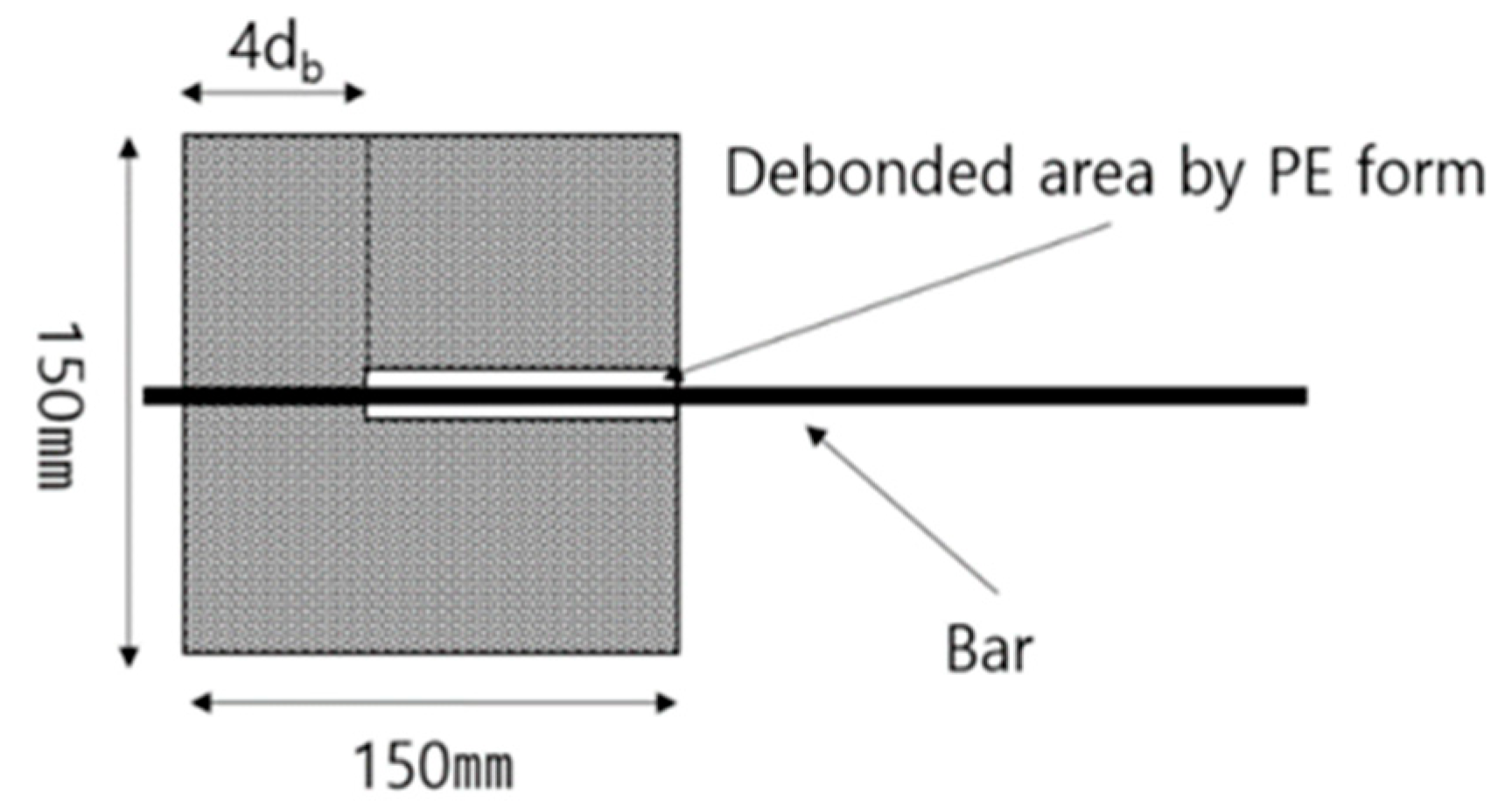
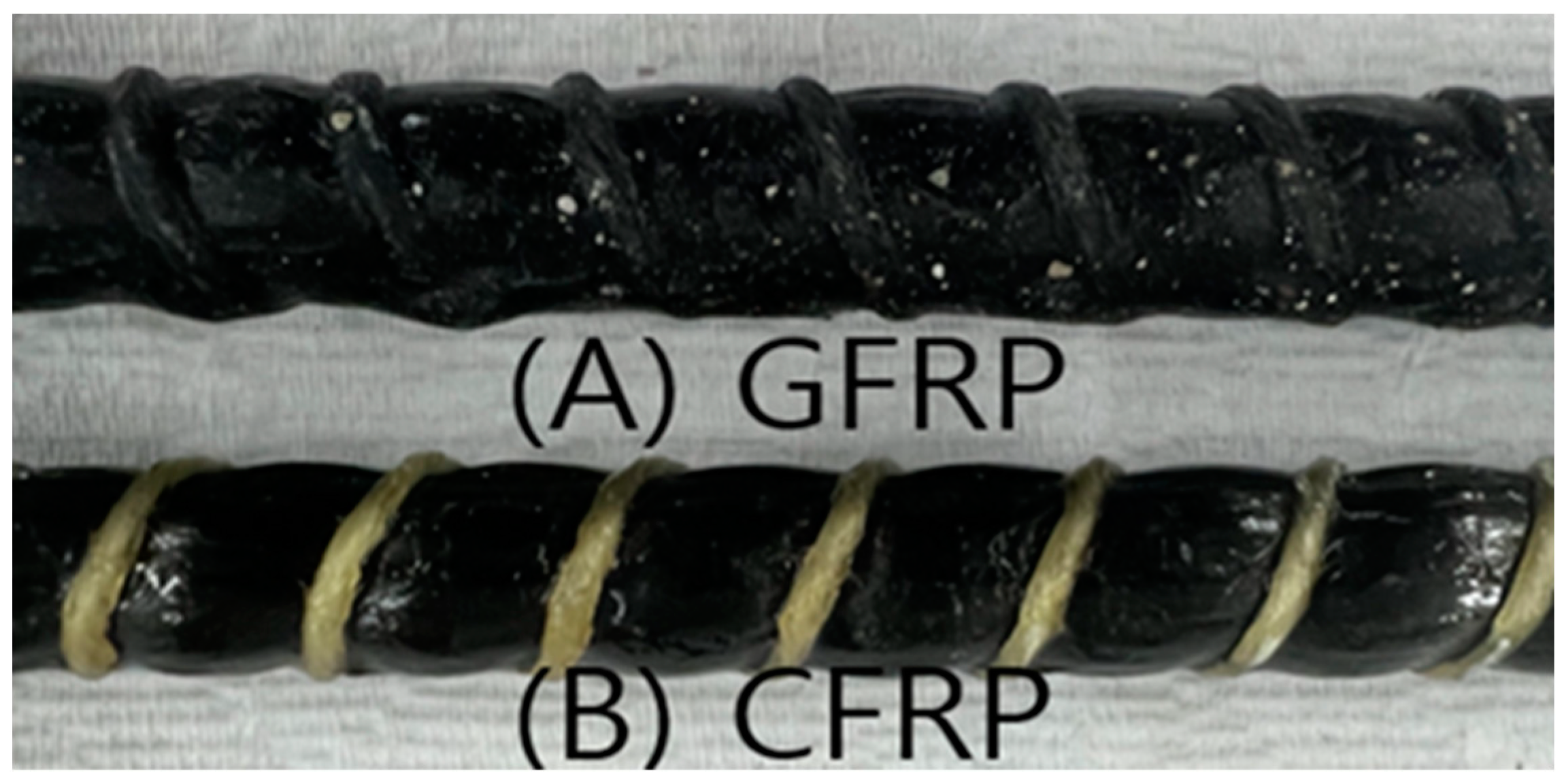

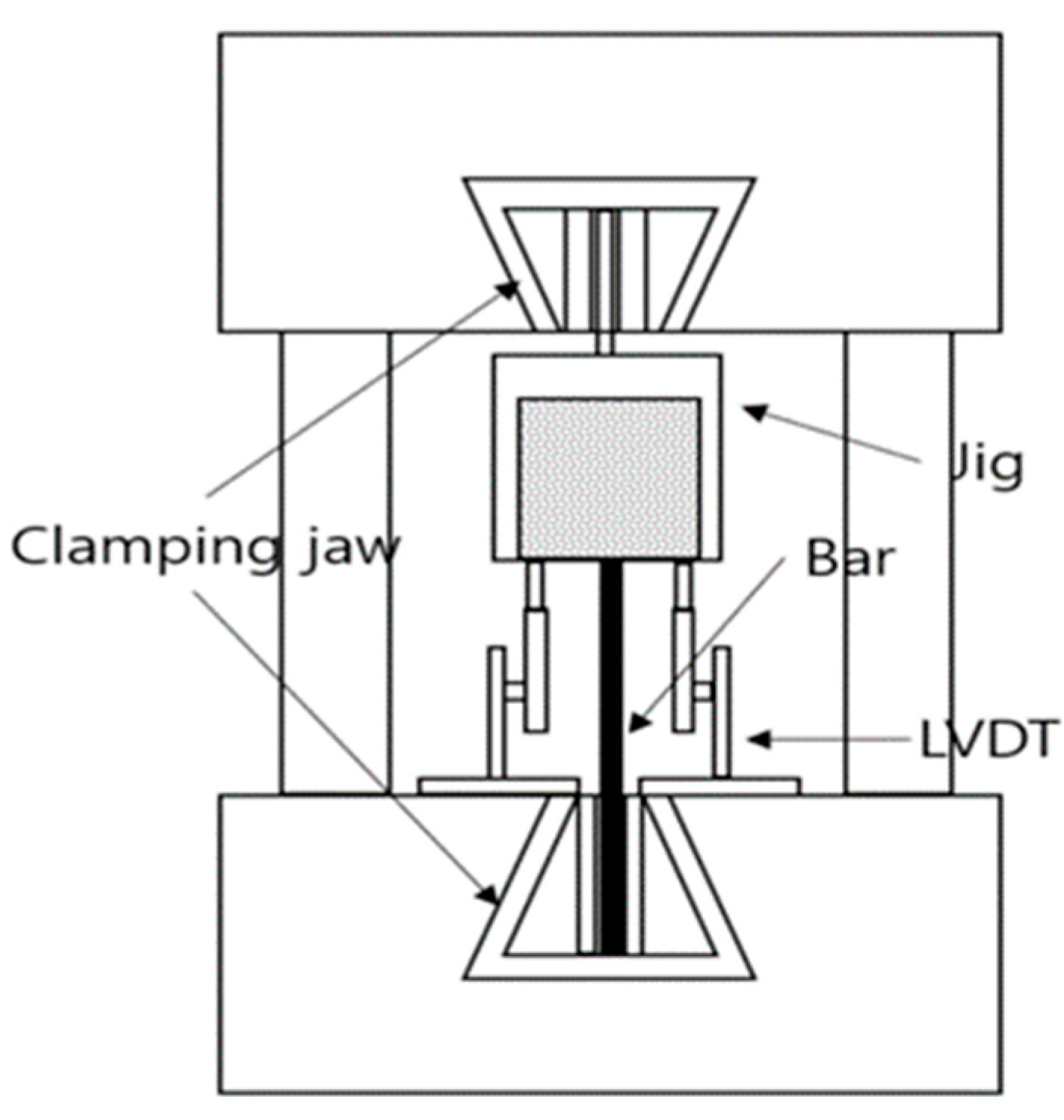
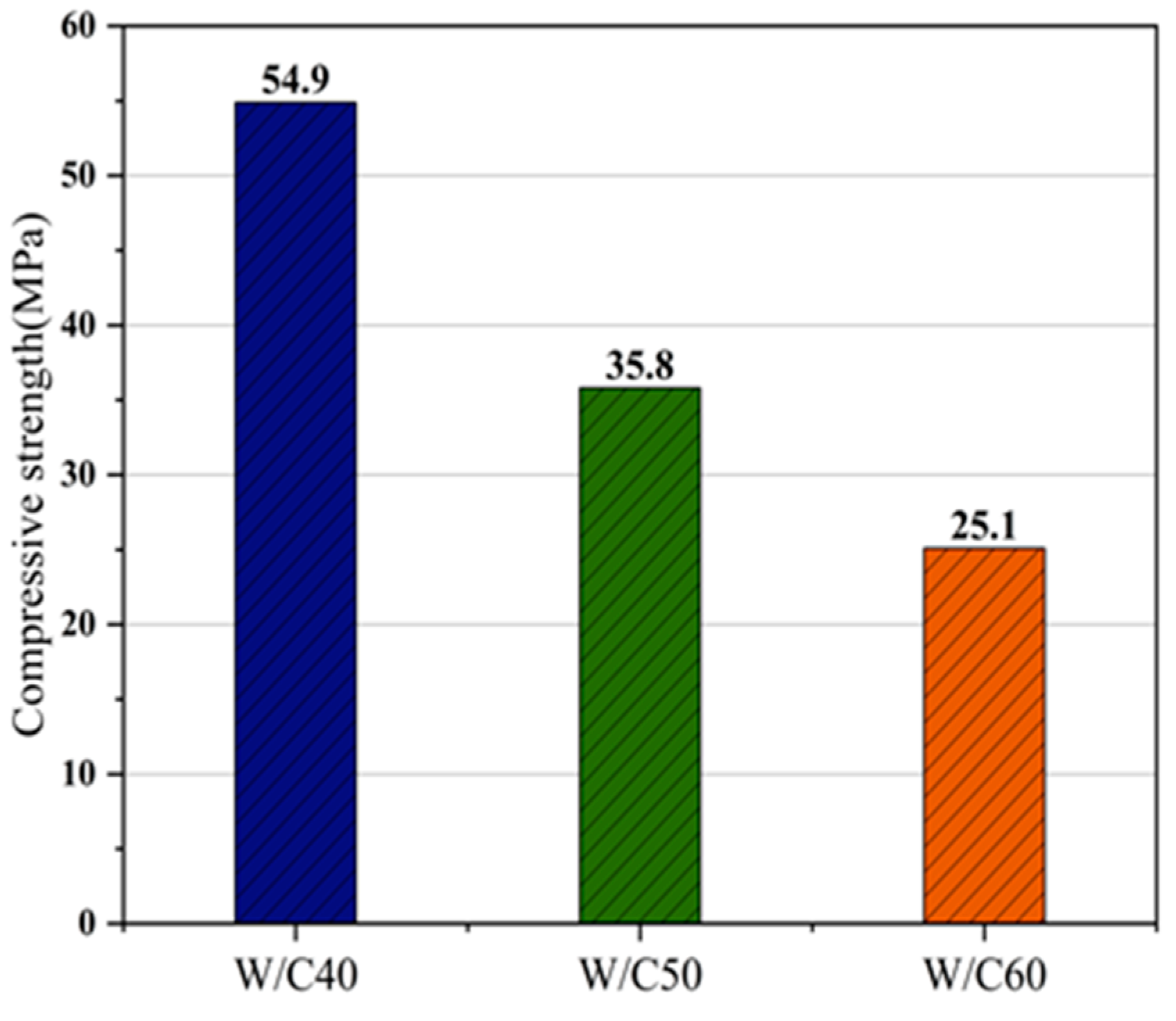
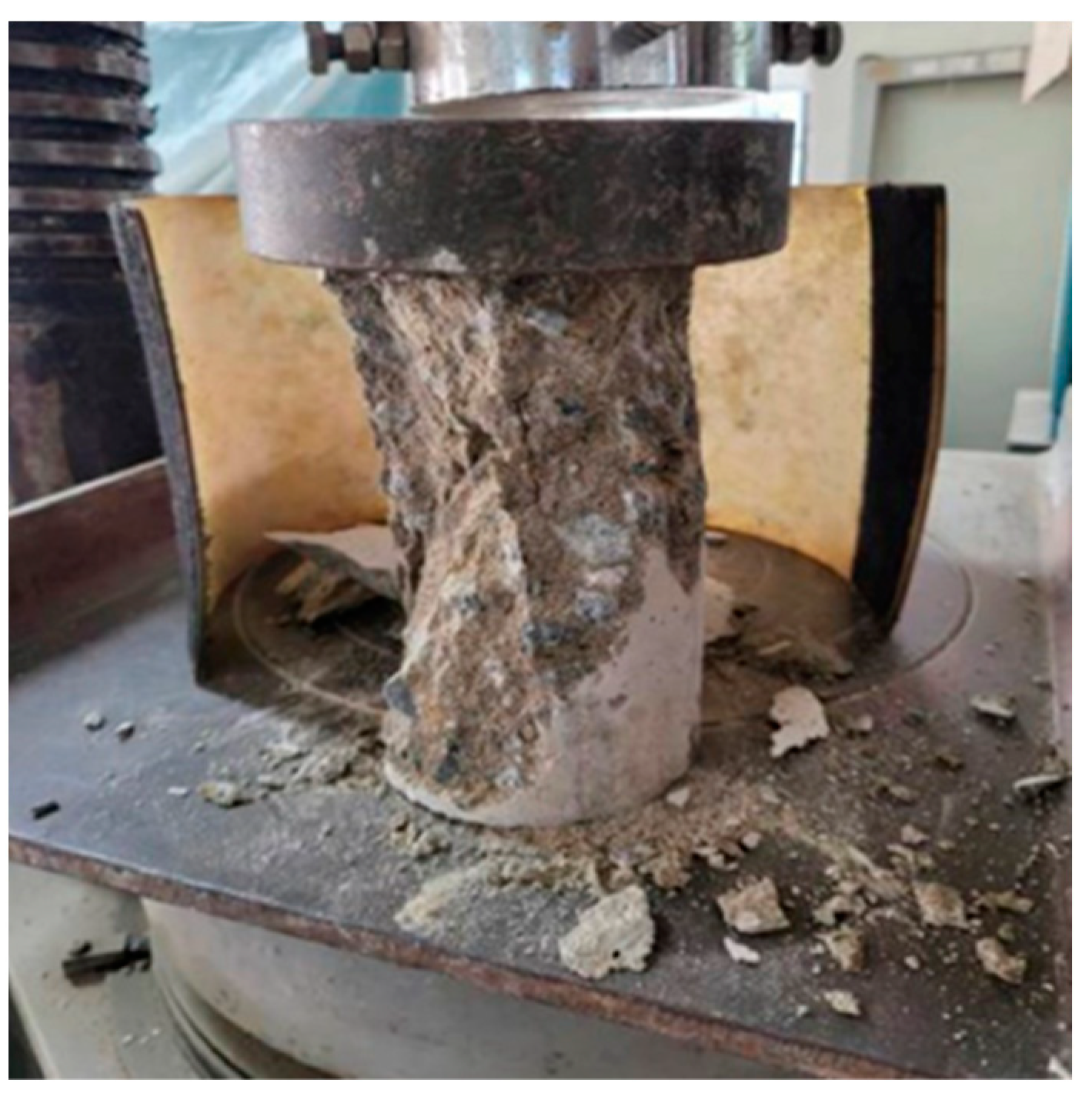
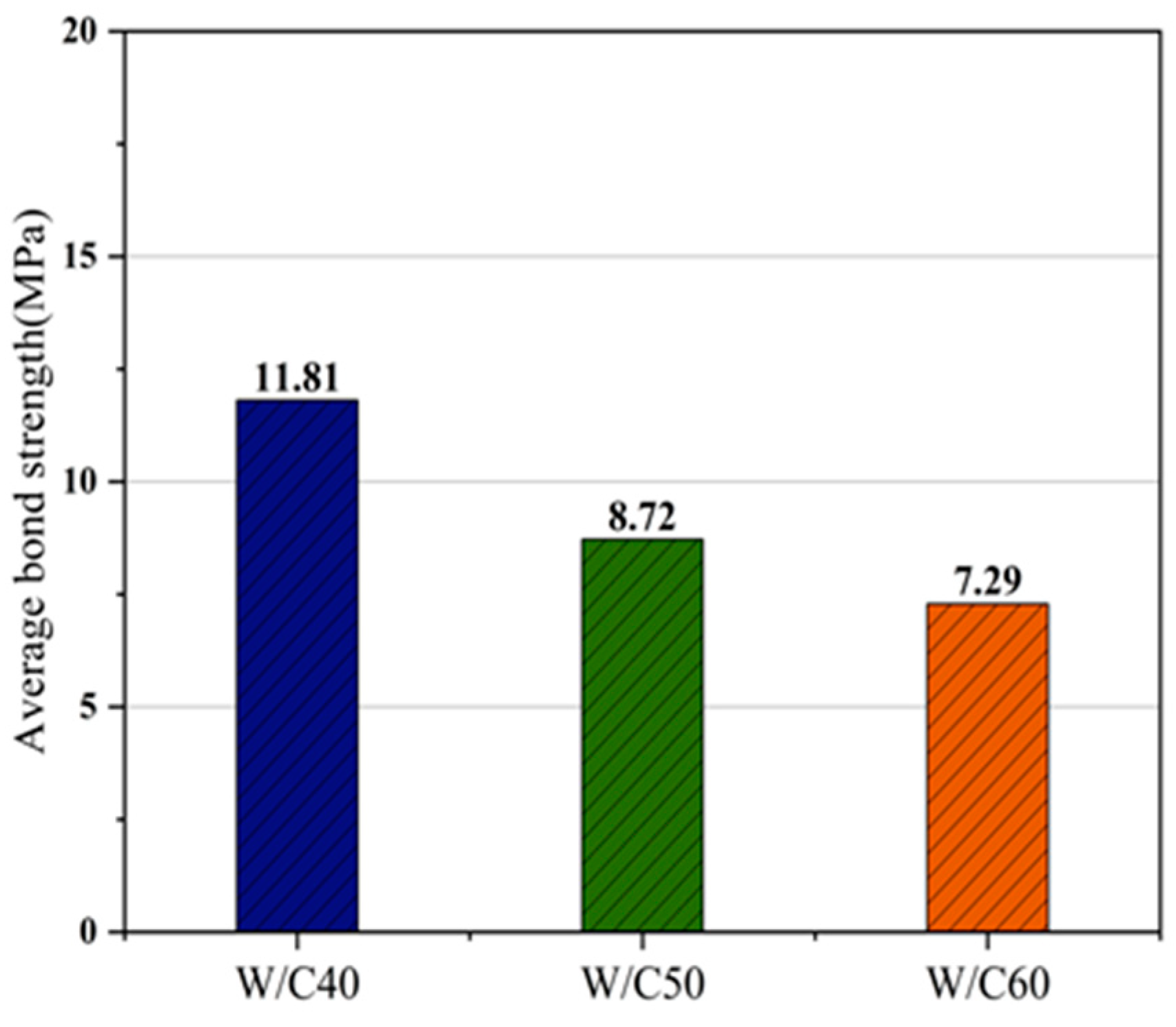
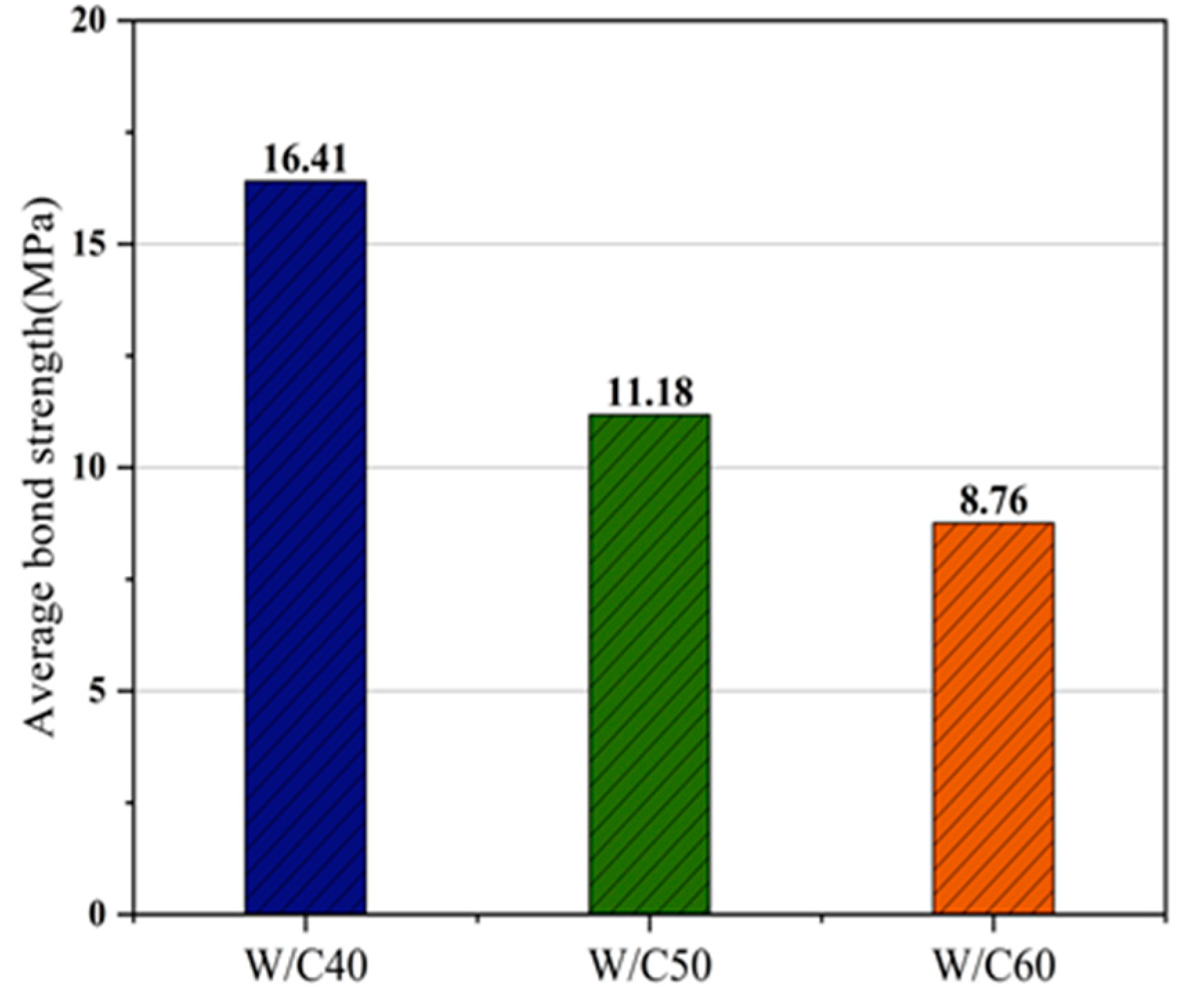


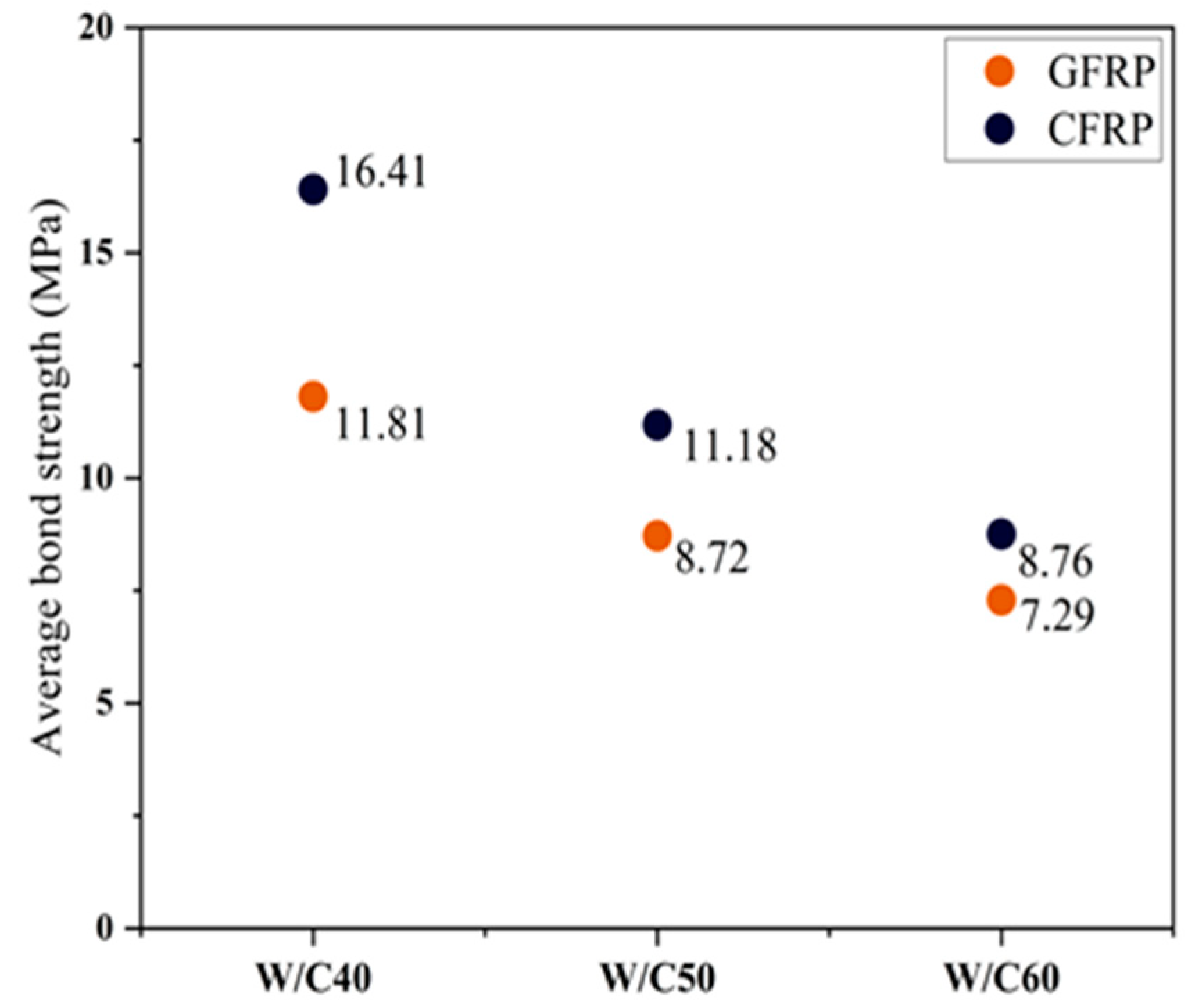
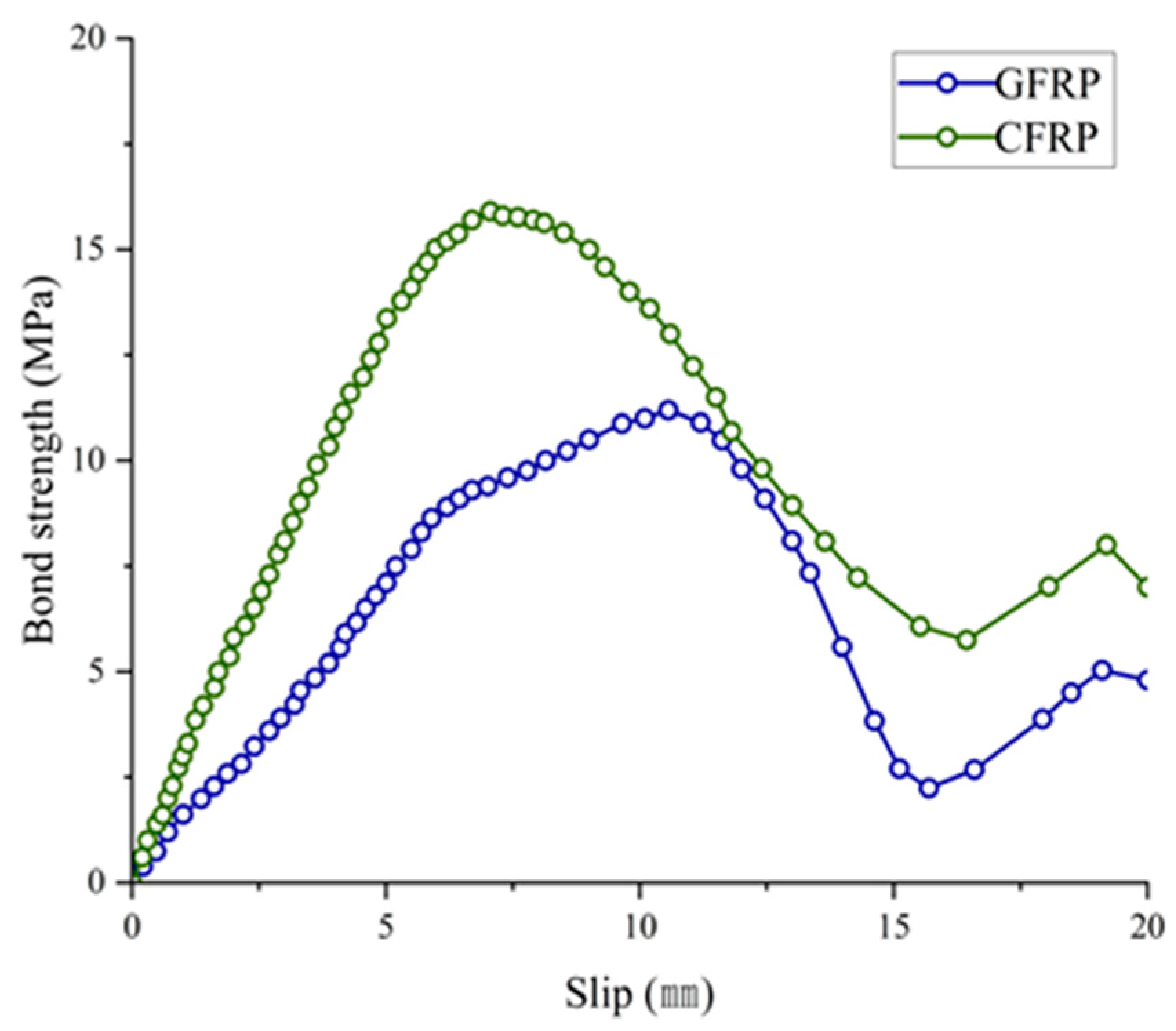
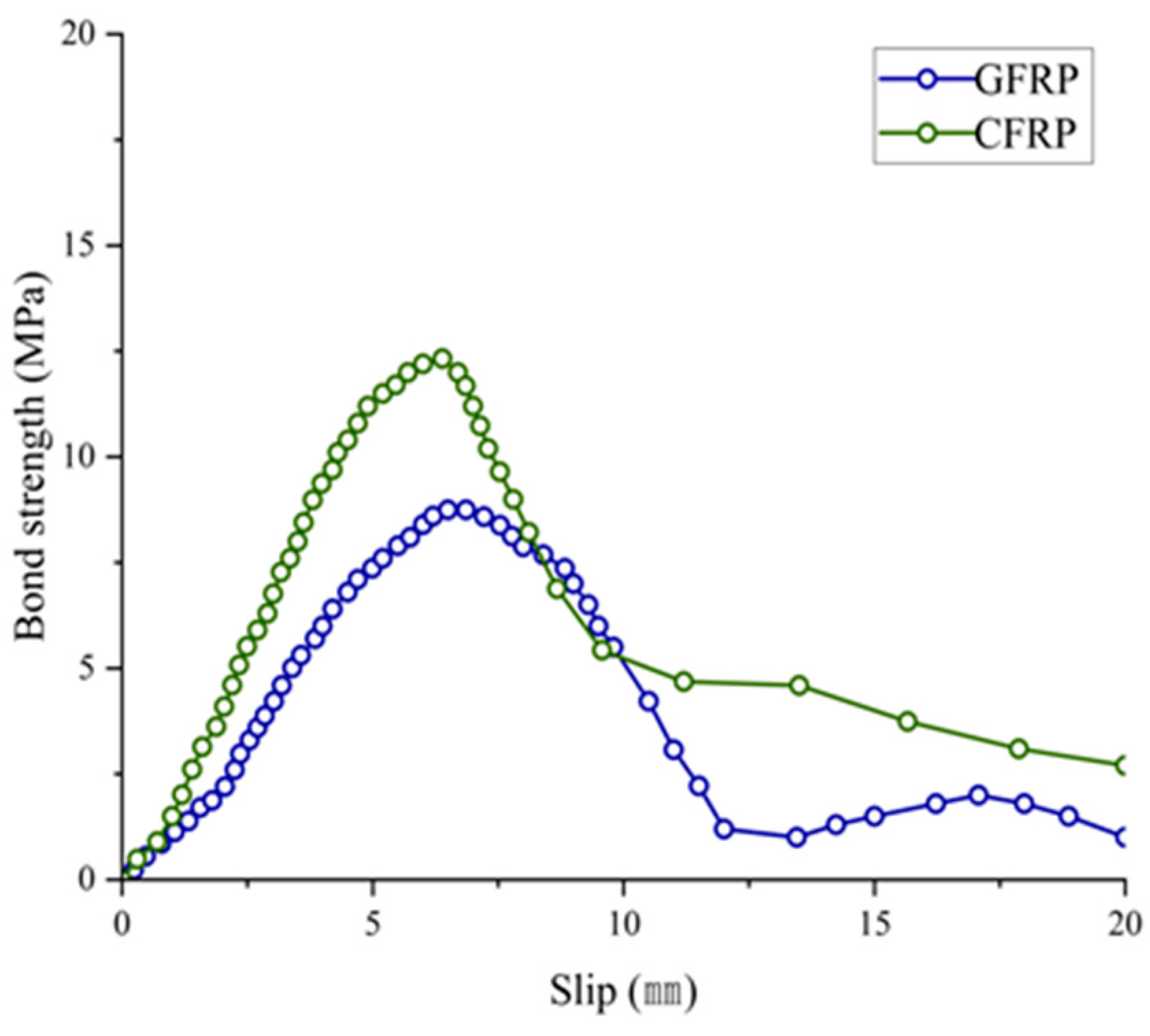
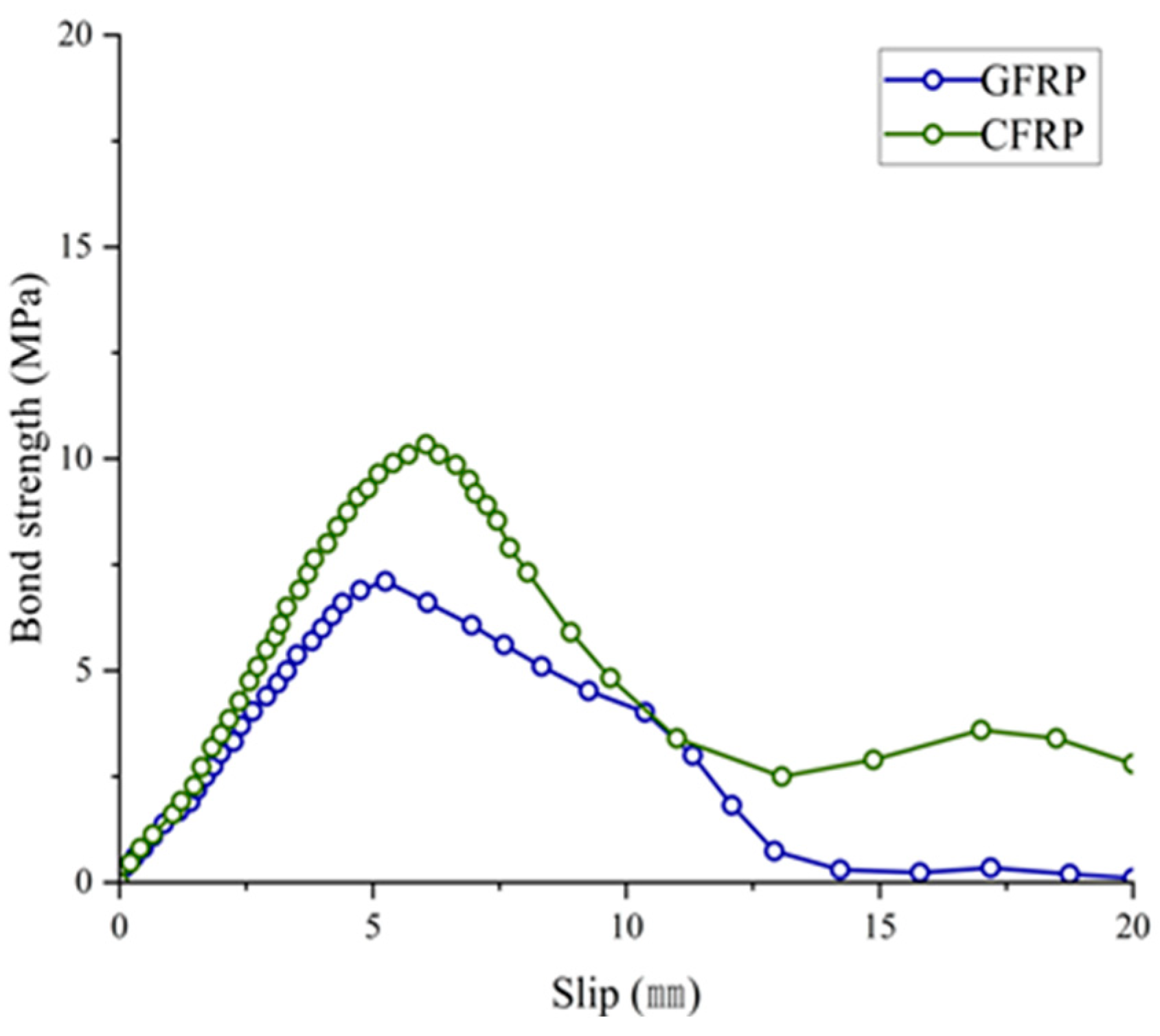
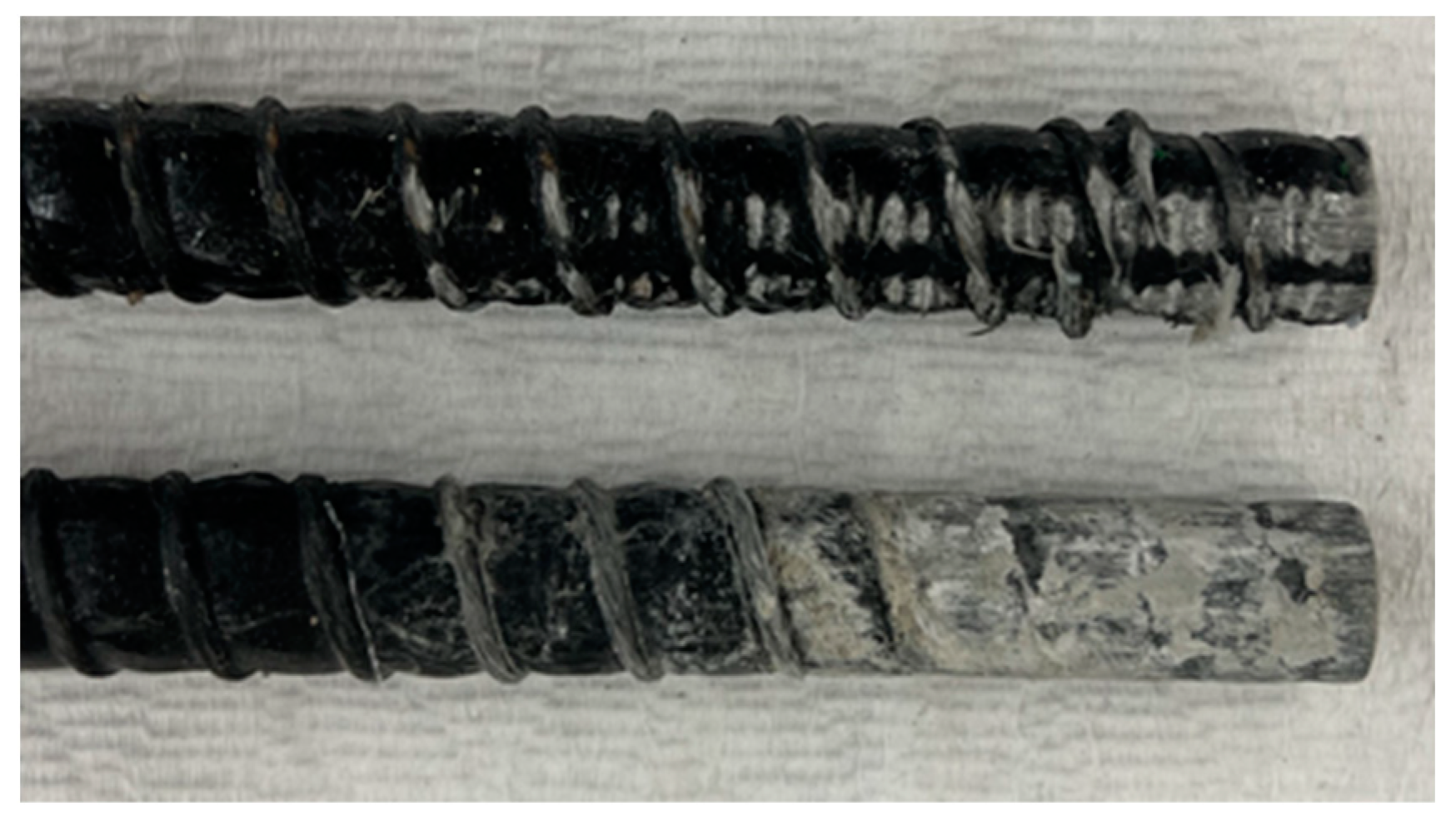
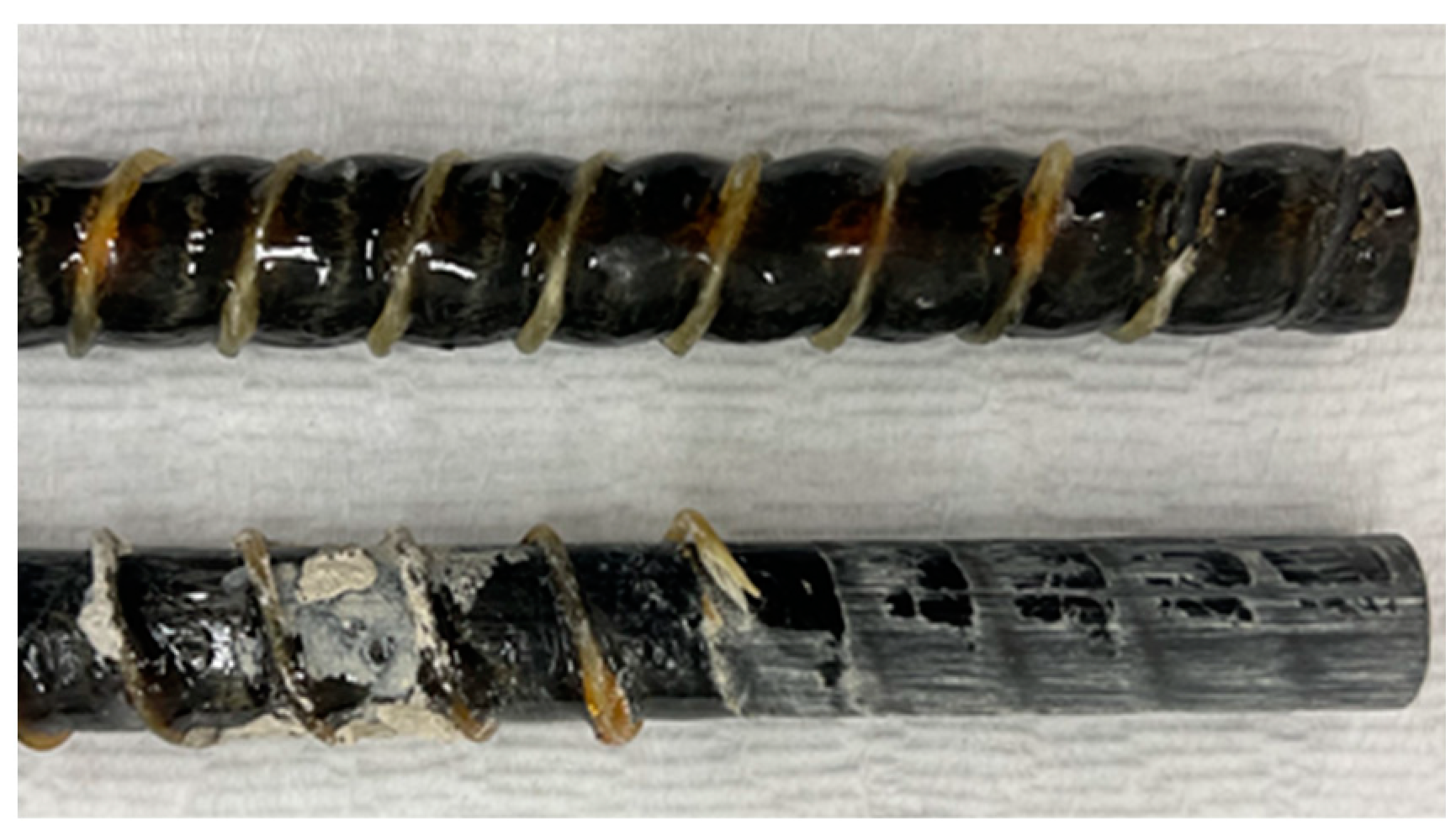
| Factors | Levels | |
|---|---|---|
| W/C (%) | 40%, 50%, 60% | 3 |
| bar type | CFRP, GFRP | 2 |
| curing condition | temperature 20 ± 2 °C | 1 |
| aggregate type | river sand and crushed gravel | 2 |
| test item | compressive strength (28 days), bond strength (28 days) | 2 |
| Diameter (mm) | Fiber | Tensile Strength (MPa) |
|---|---|---|
| 13 | glass fiber 4400TEX | 1106 |
| Diameter (mm) | Fiber | Tensile Strength (MPa) |
|---|---|---|
| 13 | carbon fiber 24K | 1714 |
| Type | Specific Gravity | Blaine (cm2/g) | Setting Time (h:m) | Compressive Strength (MPa) | |||
|---|---|---|---|---|---|---|---|
| Initial | Final | 3 Days | 7 Days | 28 Days | |||
| 1 | 3.14 | 3,750 | 4:30 | 6:20 | 36.9 | 49.1 | 60.6 |
| Type | Density (g/m3) | Fineness Modulus (g/cm2) | Absorption (%) |
|---|---|---|---|
| river sand | 2.56 | 2.57 | 0.94 |
| Type | Density (g/m3) | Fineness Modulus (g/cm2) | Absorption (%) |
|---|---|---|---|
| crushed gravel | 2.63 | 7.531 | 0.8 |
| W/C (%) | Air (%) | S/a (%) | Water (kg/m3) | Unit Weight (kg/m3) | |||||
|---|---|---|---|---|---|---|---|---|---|
| C | S | G | C | S | G | ||||
| 40 | 5 | 46 | 175 | 438 | 743 | 910 | 139 | 293 | 344 |
| 50 | 5 | 46 | 175 | 350 | 776 | 950 | 111 | 305 | 359 |
| 60 | 5 | 46 | 175 | 299 | 797 | 977 | 93 | 314 | 369 |
| Specimen Name | Ultimate State | ||
|---|---|---|---|
| Bond Strength (MPa) | Free End Slip (mm) | Load (kN) | |
| G40_13#1 | 11.29 | 11.67 | 23.96 |
| G40_13#2 | 10.69 | 11.01 | 22.69 |
| G40_13#3 | 13.48 | 9.13 | 28.61 |
| G50_13#1 | 8.45 | 6.43 | 17.94 |
| G50_13#2 | 8.75 | 8.63 | 18.57 |
| G50_13#3 | 9.00 | 6.38 | 19.10 |
| G60_13#1 | 7.85 | 10.11 | 16.66 |
| G60_13#2 | 7.11 | 5.25 | 15.09 |
| G60_13#3 | 6.95 | 11.56 | 14.75 |
| C40_13#1 | 18.72 | 10.41 | 39.74 |
| C40_13#2 | 15.84 | 8.14 | 33.62 |
| C40_13#3 | 14.70 | 23.19 | 31.20 |
| C50_13#1 | 12.33 | 6.38 | 26.17 |
| C50_13#2 | 8.89 | 6.10 | 18.87 |
| C50_13#3 | 12.35 | 11.21 | 26.21 |
| C60_13#1 | 10.34 | 6.05 | 21.95 |
| C60_13#2 | 7.71 | 16.13 | 16.37 |
| C60_13#3 | 8.24 | 12.22 | 17.49 |
| G = GFRP, C = CFRP | |||
Publisher’s Note: MDPI stays neutral with regard to jurisdictional claims in published maps and institutional affiliations. |
© 2022 by the authors. Licensee MDPI, Basel, Switzerland. This article is an open access article distributed under the terms and conditions of the Creative Commons Attribution (CC BY) license (https://creativecommons.org/licenses/by/4.0/).
Share and Cite
Kim, J.; Jeong, S.; Kim, H.; Kim, Y.; Park, S. Bond Strength Properties of GFRP and CFRP according to Concrete Strength. Appl. Sci. 2022, 12, 10611. https://doi.org/10.3390/app122010611
Kim J, Jeong S, Kim H, Kim Y, Park S. Bond Strength Properties of GFRP and CFRP according to Concrete Strength. Applied Sciences. 2022; 12(20):10611. https://doi.org/10.3390/app122010611
Chicago/Turabian StyleKim, Jusung, Sumi Jeong, Hojin Kim, Youngjin Kim, and Sungyu Park. 2022. "Bond Strength Properties of GFRP and CFRP according to Concrete Strength" Applied Sciences 12, no. 20: 10611. https://doi.org/10.3390/app122010611





